This blog is for primitive dog enthusiasts. It is part of the INDog Project www.indog.co.in. Only INDogs (India's primitive indigenous village dogs) and INDog-mixes (Indies) are featured here. The two are NOT the same, do please read the text on the right to understand the difference. Our aim: to create awareness about the primitive landrace village dog of the Indian subcontinent. I sometimes feature other landrace breeds too. Also see padsociety.org
Thursday, October 29, 2009
Romeo is still looking for a home - please help
I posted an appeal from Charu Shah earlier for this lovely puppy. Click here for the appeal and photos. Charu takes her to her apartment for a while every day, and she made these videos so we can all see what a cute, healthy and playful pup Romeo is. Come on, dog lovers - spread the word and let's find this smart little dog the great home she deserves! It'll take just a few minutes of your time to forward this appeal. Imagine the difference you could make to her life.
More Romeo movies here: Romeo and cat toy, Romeo at 2 a.m.
Charu can be contacted at shahcharu76@yahoo.com
Movies: Charu Shah
Mumbai
Monday, October 26, 2009
Pete, Jorja and autumn leaves
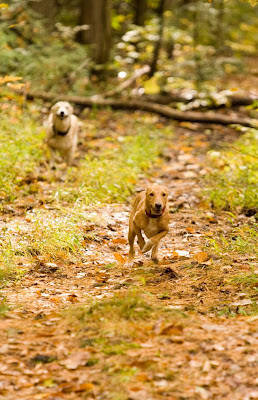



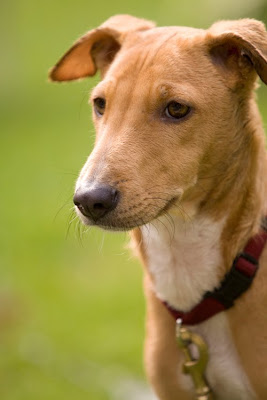





This stunning set of pictures comes from photographer/designer Sarah O'Neill, who adopted little Hugo Boss from Ahmedabad (click here and here for earlier posts on Hugo). No need to write about the great life he's having with Sarah and Ryan in Canada - you can see that from the images.
The pale beautiful Canaan Dog is Jorja, his "sibling." Canaan Dogs are the aboriginal dogs of Israel and were officially recognized long ago. Wonder when that will happen for the INDog.
Photos: Sarah O'Neill
Ottawa, Canada
My Cape Town holiday with Rishi and Leela
After our trip to Tanzania, we spent a few lovely days in sunny and windy Cape Town, visiting Yvonne and her two Indis, Leela and Rishi. Click here for my earlier Africa post.
I had last met Leela in NYC last October, and Rishi in Mumbai last December - he's my Kimaya's brother, remember?
These two dogs are extremely well-travelled and have now lived in three continents. No prizes for guessing which one they love most. Like their owner, they are enjoying every minute of their outdoorsy life in Africa - a garden of their own, long walks on the nearby golf links and runs on the beach. This is no ordinary beach either: this is Cape Town after all, and African penguins, seals and even Southern Right Whales can be spotted here.
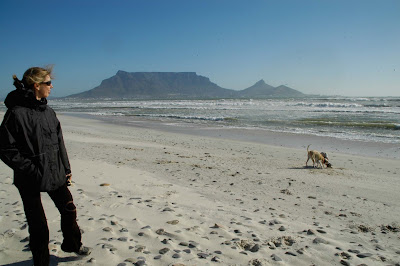

Below: Rishi rubs his face on redbait - my dogs do the same thing with strong-smelling things like dead rodents and other nasty objects

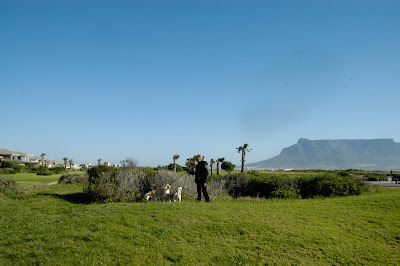
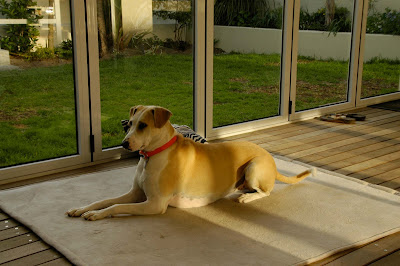
Above, below: Leela's favourite spot: she basks in the sun here, and watches the Cape Francolins who come to feed in the garden. Below: With my husband Kiran, who also enjoys basking in the sun, specially after a walk in the strong south-easterly gale!
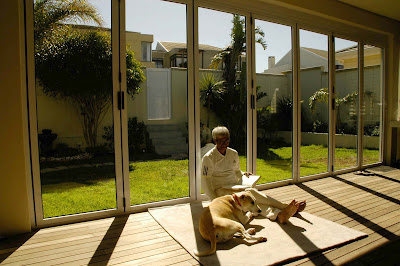
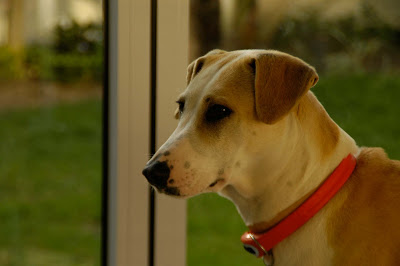
Below: Rishi has grown into a very pretty dog. Not as naughty as Kimaya (thankfully!), but just as affectionate.
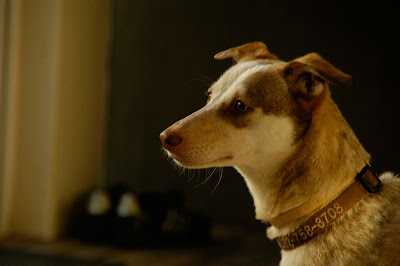
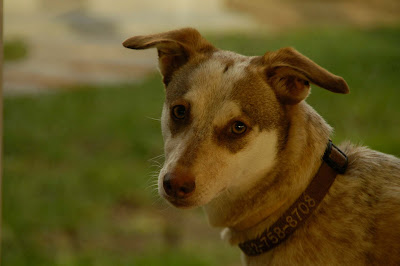
Below: He looks very like Kimaya here

Below: Leela in her day bed

Click here for some earlier posts on Leela and Rishi.
Cape Town,
South Africa
I had last met Leela in NYC last October, and Rishi in Mumbai last December - he's my Kimaya's brother, remember?
These two dogs are extremely well-travelled and have now lived in three continents. No prizes for guessing which one they love most. Like their owner, they are enjoying every minute of their outdoorsy life in Africa - a garden of their own, long walks on the nearby golf links and runs on the beach. This is no ordinary beach either: this is Cape Town after all, and African penguins, seals and even Southern Right Whales can be spotted here.
Below: Rishi rubs his face on redbait - my dogs do the same thing with strong-smelling things like dead rodents and other nasty objects
Above, below: Leela's favourite spot: she basks in the sun here, and watches the Cape Francolins who come to feed in the garden. Below: With my husband Kiran, who also enjoys basking in the sun, specially after a walk in the strong south-easterly gale!
Below: Rishi has grown into a very pretty dog. Not as naughty as Kimaya (thankfully!), but just as affectionate.
Below: He looks very like Kimaya here
Below: Leela in her day bed
Click here for some earlier posts on Leela and Rishi.
Cape Town,
South Africa
Friday, October 16, 2009
Muscadel - a Diwali story

This is a happy or a rather sad story, whichever way you want to look at it.
It happened one Diwali a few years ago. We were at our seaside house in Nagaon. We spend Diwali there every year, though it's hardly a quiet refuge from the explosions of Mumbai. Nagaon is full of tourists who think it's a good idea to ruin the beach in any way they can. At this time of year, they turn it into something like a war zone.
That weekend we were woken up early one morning by the most blood-curdling howls and shrieks, coming from somewhere in the lane outside our house. They were so loud they must have been heard by everyone in the lane - but it was absolutely impossible to identify what kind of animal was making the sounds. We rushed out to check the hedges and ditch outside, and we found this tiny pup, just over a month old, cowering and howling, out of his mind with fright as so many dogs are during Diwali.
He was so scared he wouldn't let us touch him, but we managed to lure him into our garden by showing him a bowl of milk, and once inside he started wagging his little tail and letting us pick him up. Of course in a very short while we were all in love with him - or rather, my husband and I were in love with him, and our servant Gharat liked him too. I can't say the same for Lalee or Lucy though they were well-behaved and tolerant as always. We decided to keep him as our Nagaon pup.
I named him Muscadel: not after the grape, but after a character in an unusual fairy story I read as a child (I think it was by E. Nesbit.) It was to be shortened to "Muska," which means "butter" in Marathi.
A day or two later we returned to Mumbai, leaving Muscadel in Nagaon. The first thing I did was go to a pet accessories store and buy him a pretty collar and leash. They were blue, with a pattern of stars. I also got him a feeding bowl and brush and toys. I planned to return the next day to put him in his collar.
So much for all my plans! Gharat called in the morning to say that a young man from the village had come to the house, claiming that the pup was his. He had been looking for him all over, and our neighbours told him we had just taken in a new pup that had appeared in the area. Apparently the man had recently adopted the pup, and he had then gone out of the house, asking his sister to take care of him for a while. His sister had obviously not been very attentive and the pup had run off in panic when he heard firecrackers.
Gharat asked the man to wait for a day and come and meet me, so I could satisfy myself that he was indeed Muscadel's owner. But the man refused to wait: who were we to prevent him from taking his own puppy home? (Never mind that his puppy had been rescued by us!)
The good thing is that Muscadel recognized the man and was apparently ecstatic to see him - so he really was his puppy as he claimed.
I never saw Muscadel again, but I do hope he is living happily ever after. I remembered him yesterday because I was cleaning out my dressing table drawers, and there was his star-patterned blue leash, still brand new and unworn.
I guess this is a happy story after all...
Nagaon
Update on Disco!




Remember the cute little pups Sudhir Arora had put up for adoption in August? Here's the link to the earlier appeal.
Sadly, one of the pups died. But the good news is, the little female is very healthy and is growing into a fine little dog. She's eight weeks old now and has been named Disco because of her many moves!
Please contact Sudhir on sudhirarora85@gmail.com or 91-9004038563. The pup is in Mumbai.
Photos: Sudhir Arora
Diwali woes - how to cope
I had posted these tips from canine behaviour consultant Shirin Merchant back in 2007. For those who haven't read it, here's the link. There's also the note I'd added on a homeopathic remedy which helps dogs cope with those scary loud noises. The comments are helpful too, so do read them.
Sunday, October 4, 2009
Romeo sleeps in the rain all night - please help find a home!

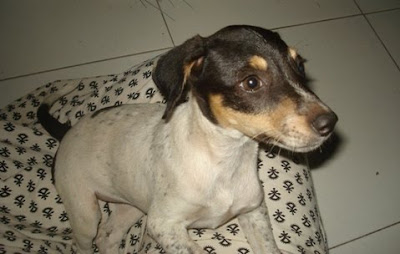

This beautiful puppy arrived in Charu Shah's building compound some days ago. A local child brought her there, but he claims the pup followed him and he doesn't know where her original home is. The building residents dislike animals and Charu can't keep this one in the compound much longer, as she already takes care of nine dogs there. The pup is living in an open yard and getting drenched in the rain and crying every night for hours. Please spread this appeal to everyone you can and try to get her adopted! She's very playful and affectionate and will make a wonderful pet.
Contact Charu at shahcharu76@yahoo.com
Mumbai
Saturday, October 3, 2009
Africa snapsots
We've just returned from a fabulous trip to Tanzania followed by a few days in Cape Town and the beautiful Cape area.
The last two weeks have been filled with spectacular wildlife, ranging from big cats and ostriches to penguins and whales. There was very little time for anything else! But I did of course manage to click a few dogs.
Here they are:
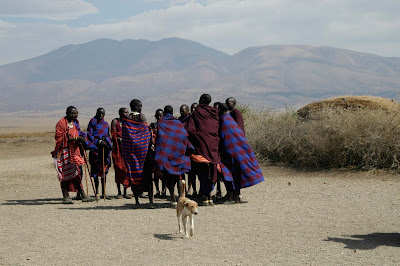
Above, below: Maasai village, Tanzania, somewhere between Serengeti National Park and Ngorongoro Crater. The Maasai, as everyone knows, are nomadic herdsmen. In Tanzania dogs do not seem to be used for guarding livestock on the same scale as in India. This was just my impression and it may be a wrong one, since I was in Africa for only a fortnight. They are used more often as watchdogs, and by some as hunting dogs, though not by the Maasai - this tribe doesn't hunt, they kill and eat only their own cattle. Only two of the many herds we saw were accompanied by dogs.
In this village we visited there were only four dogs (and 74 humans).


Above, below: This little brown bitch was the only healthy and well-fed one of the four. Two of the dogs were painfully thin and looked as if they wouldn't live long. However, this village may have been an exception, as all the other dogs we saw on our travels seemed healthy and well-cared-for. Probably the people here are very poor and don't have much food to spare. The landscape is quite barren in this area and life must be very hard.

These dogs were wary of strangers, and apparently not used to much petting. They didn't allow me to touch them. In fact, the bitch above wasn't really comfortable with even these villagers touching her.
Below: We met this handsome dog accompanying a herd of goats and two little Maasai boys, up on the rim of the Ngorongoro Crater. The dogs are very like our INDogs, but with bushier tails.
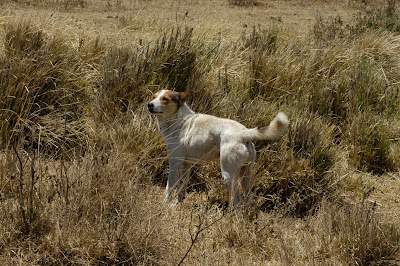
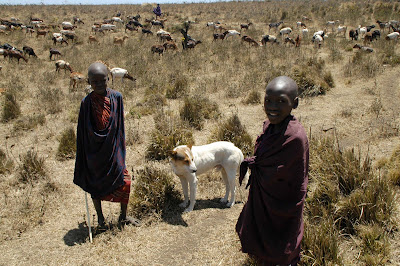
I didn't have time to click dogs elsewhere, though we did pass through villages occupied by another tribe, the Sukuma. They don't follow a traditional lifestyle like the Maasai, and the villages are much more prosperous and "mainstream." There were quite a few dogs lying around, all healthy and well-looked-after.
Our guide told us that vaccination of dogs against rabies is compulsory, and that the government vets do this free at regular intervals. Unvaccinated dogs are shot. Obviously, this is a very strong incentive for people to get their dogs immunized. The rule sounds harsh, but perhaps such draconian measures are needed to shake dog-owners out of their apathy. After all, if protection against rabies is provided free, there is really no excuse for not availing of it.
Another dreaded canine disease comes to mind while speaking of Tanzania: Canine Distemper Virus (CDV). In 1994 domestic dogs transmitted this virus to the lions in Serengeti National Park, resulting in the death of 1000 of these magnificent big cats. In fact, in the 1990s the Wild Dog population there was wiped out by CDV, and apparently they started making a comeback in the area only after the domestic dogs around the park were vaccinated against the disease.
I wonder when our Indian powers-that-be will understand the catastrophic consequences of these diseases for humans and animals. Are they aware that both the diseases are easily preventable? Even if they were smart enough to comprehend this simple information, it's unlikely that they would take any action. Can you imagine our authorities actually going around vaccinating dogs? That kind of thing is left to more intelligent and civilized nations. Stupidity and ignorance are the hallmarks of Indian officialdom, and we can only expect foolish policies that benefit neither man nor beast.
For those who think I'm being unnecessarily sarcastic, I am repeating a fact I mentioned in this earlier post: some of our municipal corporations are reported to actually capture street dogs from cities and villages and release them in wildlife areas, including in places like the Gir forest - last home of the Asiatic Lion - and the Rann of Kutch, home of the endangered Asiatic Wild Ass. A shining example of our government's attitude towards our vanishing wildlife, which they are supposed to be protecting. It's hard to imagine the plight of the poor dogs left in such areas.
So, back to Africa after that tirade. The dog below is not a Pariah Dog or any other type of African dog; he belongs to another ancient breed, the famous Anatolian Shepherd Dog or "Kangal." I photographed him in Stellenbosch not far from Cape Town, in the premises of a cheetah protection organization called Cheetah Outreach.
So what's a Turkish shepherd dog got to do with cheetahs? He's part of an interesting programme that provides these dogs to farmers in the region, as a non-lethal method of protecting livestock against cheetahs and other wild predators. The dogs are huge. Apparently the programme has had encouraging results in South Africa and Namibia.

And finally, the dogs we spent the longest time with in South Africa were two Indian dogs: Rishi and Leela! But I'm saving those pictures for another post.
Ngorongoro Conservation Area,Tanzania
Stellenbosch, South Africa
The last two weeks have been filled with spectacular wildlife, ranging from big cats and ostriches to penguins and whales. There was very little time for anything else! But I did of course manage to click a few dogs.
Here they are:
Above, below: Maasai village, Tanzania, somewhere between Serengeti National Park and Ngorongoro Crater. The Maasai, as everyone knows, are nomadic herdsmen. In Tanzania dogs do not seem to be used for guarding livestock on the same scale as in India. This was just my impression and it may be a wrong one, since I was in Africa for only a fortnight. They are used more often as watchdogs, and by some as hunting dogs, though not by the Maasai - this tribe doesn't hunt, they kill and eat only their own cattle. Only two of the many herds we saw were accompanied by dogs.
In this village we visited there were only four dogs (and 74 humans).


Above, below: This little brown bitch was the only healthy and well-fed one of the four. Two of the dogs were painfully thin and looked as if they wouldn't live long. However, this village may have been an exception, as all the other dogs we saw on our travels seemed healthy and well-cared-for. Probably the people here are very poor and don't have much food to spare. The landscape is quite barren in this area and life must be very hard.
These dogs were wary of strangers, and apparently not used to much petting. They didn't allow me to touch them. In fact, the bitch above wasn't really comfortable with even these villagers touching her.
Below: We met this handsome dog accompanying a herd of goats and two little Maasai boys, up on the rim of the Ngorongoro Crater. The dogs are very like our INDogs, but with bushier tails.
I didn't have time to click dogs elsewhere, though we did pass through villages occupied by another tribe, the Sukuma. They don't follow a traditional lifestyle like the Maasai, and the villages are much more prosperous and "mainstream." There were quite a few dogs lying around, all healthy and well-looked-after.
Our guide told us that vaccination of dogs against rabies is compulsory, and that the government vets do this free at regular intervals. Unvaccinated dogs are shot. Obviously, this is a very strong incentive for people to get their dogs immunized. The rule sounds harsh, but perhaps such draconian measures are needed to shake dog-owners out of their apathy. After all, if protection against rabies is provided free, there is really no excuse for not availing of it.
Another dreaded canine disease comes to mind while speaking of Tanzania: Canine Distemper Virus (CDV). In 1994 domestic dogs transmitted this virus to the lions in Serengeti National Park, resulting in the death of 1000 of these magnificent big cats. In fact, in the 1990s the Wild Dog population there was wiped out by CDV, and apparently they started making a comeback in the area only after the domestic dogs around the park were vaccinated against the disease.
I wonder when our Indian powers-that-be will understand the catastrophic consequences of these diseases for humans and animals. Are they aware that both the diseases are easily preventable? Even if they were smart enough to comprehend this simple information, it's unlikely that they would take any action. Can you imagine our authorities actually going around vaccinating dogs? That kind of thing is left to more intelligent and civilized nations. Stupidity and ignorance are the hallmarks of Indian officialdom, and we can only expect foolish policies that benefit neither man nor beast.
For those who think I'm being unnecessarily sarcastic, I am repeating a fact I mentioned in this earlier post: some of our municipal corporations are reported to actually capture street dogs from cities and villages and release them in wildlife areas, including in places like the Gir forest - last home of the Asiatic Lion - and the Rann of Kutch, home of the endangered Asiatic Wild Ass. A shining example of our government's attitude towards our vanishing wildlife, which they are supposed to be protecting. It's hard to imagine the plight of the poor dogs left in such areas.
So, back to Africa after that tirade. The dog below is not a Pariah Dog or any other type of African dog; he belongs to another ancient breed, the famous Anatolian Shepherd Dog or "Kangal." I photographed him in Stellenbosch not far from Cape Town, in the premises of a cheetah protection organization called Cheetah Outreach.
So what's a Turkish shepherd dog got to do with cheetahs? He's part of an interesting programme that provides these dogs to farmers in the region, as a non-lethal method of protecting livestock against cheetahs and other wild predators. The dogs are huge. Apparently the programme has had encouraging results in South Africa and Namibia.

And finally, the dogs we spent the longest time with in South Africa were two Indian dogs: Rishi and Leela! But I'm saving those pictures for another post.
Ngorongoro Conservation Area,Tanzania
Stellenbosch, South Africa
Subscribe to:
Posts (Atom)

